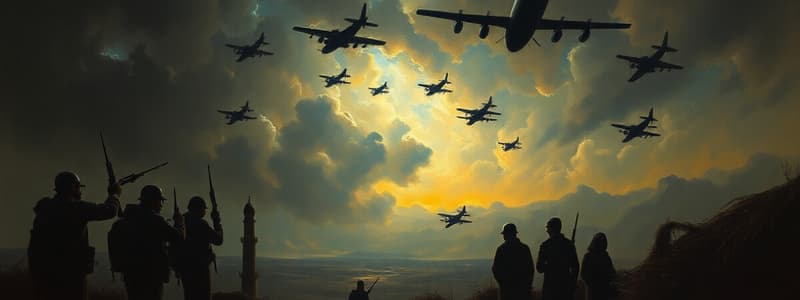Podcast
Questions and Answers
The family's immediate response to the initial bombing, characterized by huddling and shared fear, most acutely exemplifies which psychological phenomenon prevalent in acute conflict situations?
The family's immediate response to the initial bombing, characterized by huddling and shared fear, most acutely exemplifies which psychological phenomenon prevalent in acute conflict situations?
- Cognitive dissonance reduction, where shared fear serves to rationalize and normalize the experience of violence, diminishing individual anxiety.
- Learned helplessness, manifesting as a passive acceptance of danger due to perceived lack of control over environmental stressors.
- Attachment insecurity activation, leading to heightened proximity-seeking behaviors towards primary caregivers as a primal safety response. (correct)
- Collective effervescence, wherein shared emotional experiences amplify group cohesion and resilience against external threats.
The children's development of a system to discern the proximity of fighting based on electricity outages represents a form of adaptive behavior most closely aligned with which concept in ecological psychology?
The children's development of a system to discern the proximity of fighting based on electricity outages represents a form of adaptive behavior most closely aligned with which concept in ecological psychology?
- Environmental press adaptation, demonstrating a passive adjustment to environmental demands without actively altering the environment.
- Behavioral plasticity, showcasing the capacity for phenotypic change in response to environmental cues, specifically threat detection. (correct)
- Affordance perception, where the environment's properties are directly perceived in terms of possibilities for action, regardless of danger.
- Ecological niche construction, actively modifying their immediate surroundings to mitigate the impacts of environmental stressors.
Malala's progressive expansion of her prayer's scope, from family to the entire world, during the bombings, can be best interpreted through the lens of which psychological defense mechanism, operating at a societal level?
Malala's progressive expansion of her prayer's scope, from family to the entire world, during the bombings, can be best interpreted through the lens of which psychological defense mechanism, operating at a societal level?
- Displacement, redirecting the anxiety and helplessness experienced in the immediate conflict zone towards a more abstract and diffuse concern for global peace. (correct)
- Intellectualization, abstracting the emotional distress of immediate danger into a broader, philosophical concern for global well-being.
- Sublimation, channeling unacceptable anxieties into socially constructive and universally benevolent desires for global peace and harmony.
- Reaction formation, transforming the personal fear and vulnerability into an outwardly expressed, exaggerated concern for universal safety.
The narrative's depiction of the family becoming 'used to the bombing and shelling' to the extent that 'Atal slept through it' most accurately illustrates which neurobiological adaptation to chronic traumatic stress?
The narrative's depiction of the family becoming 'used to the bombing and shelling' to the extent that 'Atal slept through it' most accurately illustrates which neurobiological adaptation to chronic traumatic stress?
The initial rumor that 'The Taliban were going to take control of Swat' following the first night of bombing, despite the army's presence, best exemplifies which phenomenon in conflict-induced information environments?
The initial rumor that 'The Taliban were going to take control of Swat' following the first night of bombing, despite the army's presence, best exemplifies which phenomenon in conflict-induced information environments?
Malala's recitation of Ayat al-Kursi, escalating the number of repetitions to extend the protective scope, demonstrates a form of ritualistic behavior most closely paralleling which concept in comparative religion and anthropology?
Malala's recitation of Ayat al-Kursi, escalating the number of repetitions to extend the protective scope, demonstrates a form of ritualistic behavior most closely paralleling which concept in comparative religion and anthropology?
The narrative statement, 'One day my prayer was answered. The army hadn't won, but it had at least driven the Taliban into hiding, if not away,' reflects a resolution that most accurately embodies which type of conflict outcome in political science?
The narrative statement, 'One day my prayer was answered. The army hadn't won, but it had at least driven the Taliban into hiding, if not away,' reflects a resolution that most accurately embodies which type of conflict outcome in political science?
The contrast between the 'oddly still' air the morning after the initial bombing and the preceding night of intense violence highlights which psychological effect commonly observed in the aftermath of acute traumatic events within a community?
The contrast between the 'oddly still' air the morning after the initial bombing and the preceding night of intense violence highlights which psychological effect commonly observed in the aftermath of acute traumatic events within a community?
The father's 'frowning' reaction upon returning with the rumor, 'The Taliban were going to take control of Swat,' despite the army's operation, most likely indicates which form of cognitive appraisal in a high-stakes, uncertain environment?
The father's 'frowning' reaction upon returning with the rumor, 'The Taliban were going to take control of Swat,' despite the army's operation, most likely indicates which form of cognitive appraisal in a high-stakes, uncertain environment?
The description of the army's shelling originating 'from helicopters and cannons fired from mountaintops' implicitly suggests a military strategy primarily aimed at achieving which tactical objective in asymmetric warfare?
The description of the army's shelling originating 'from helicopters and cannons fired from mountaintops' implicitly suggests a military strategy primarily aimed at achieving which tactical objective in asymmetric warfare?
Flashcards
Bombing
Bombing
An attack involving explosives, often used by the Taliban.
Shelling
Shelling
Artillery attacks from helicopters and mountaintops, conducted by the army.
Machine guns
Machine guns
A type of firearm used by both the army and the Taliban.
Ayat al-Kursi
Ayat al-Kursi
Signup and view all the flashcards
Military operation
Military operation
Signup and view all the flashcards
Taliban control
Taliban control
Signup and view all the flashcards
Family dynamics in war
Family dynamics in war
Signup and view all the flashcards
Living with fear
Living with fear
Signup and view all the flashcards
Hope during conflict
Hope during conflict
Signup and view all the flashcards
Prayers for peace
Prayers for peace
Signup and view all the flashcards
Study Notes
A Night of Bombing
- The narrator and siblings hid during a bombing raid
- A bright flash of light illuminated the room
- The house shook, dishes clattered, and windows rattled
- Gunfire followed the light flash, causing fear and anxiety
- Gripped tightly together, they drifted off to sleep
The Next Morning's Rumor
- The morning after the bombing was unusually quiet
- The narrator, brother, and sister were hopeful the Taliban had been defeated
- They peeked outside to see neighbors gossiping
- The father inquired and found out that the Taliban were in control of the city
- The news of the Taliban's impending takeover caused fear and concern
Types of Attacks
- Three types of attacks: bombing, shelling, and machine guns
- Bombing done by the Taliban (sometimes remotely triggered) or suicide bombers
- Shelling involves helicopters and cannons on mountaintops, mostly carried out by the army
- Machine guns were used by both sides
Prayer and Hope
- The narrator used a special verse from the Holy Quran, the Ayat al-Kursi
- Reciting the verse three or more times is a prayer for security
- The narrator prayed for protection for family, neighborhood, Swat, and Pakistan, and the world.
- The narrator and family experienced fear but still found peace each morning
- The narrator wished for peace in Swat
Studying That Suits You
Use AI to generate personalized quizzes and flashcards to suit your learning preferences.




